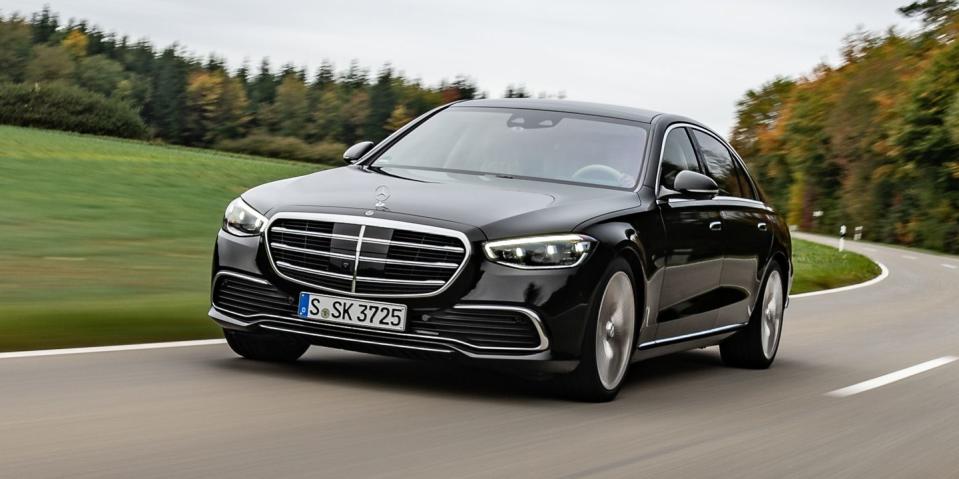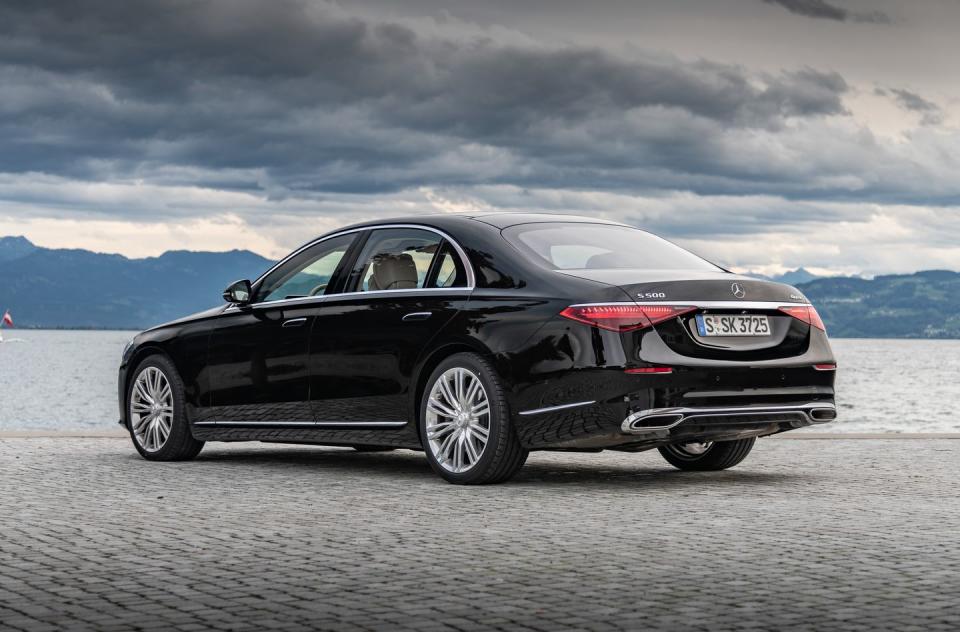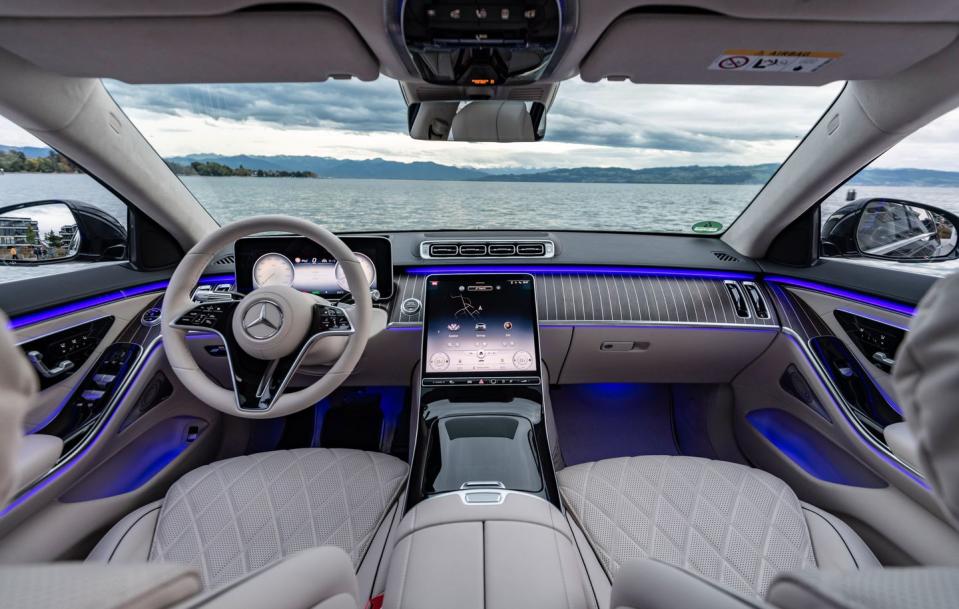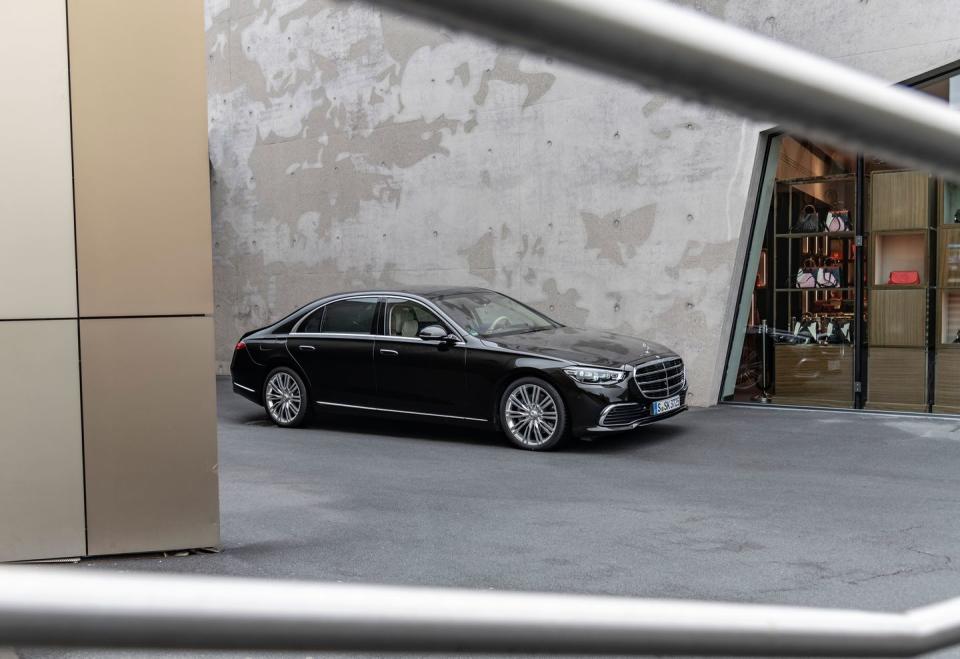2021 Mercedes-Benz S-Class Advances the High-Tech Luxury Sedan

Upmarket car buyers are showing an increased preference for SUVs pretty much everywhere in the world, yet the S-class remains—explicitly—the flagship model for Mercedes. A new generation of the Sonderklasse always serves as both a range-topping luxury sedan and a tech showcase for features that will soon trickle down to lesser Benzes. Mercedes is rightly proud of the many innovations that previous S-classes introduced, including anti-lock brakes (1981), stability control (1995), radar cruise control (1998), and all-LED exterior lighting (2013). There have been a few that didn't trickle so much, too. Remember the "parking wands" that rose from the rear corners of the 1991 W140 generation to make it slightly easier to back that behemoth trunk toward a parking spot?
While there is indeed an abundance of new features in the new S-class, the first impression is of what's missing—namely, bravado. This generation (W223 in Benz code) is less ostentatious than its predecessor, lacking the old car's baroque detailing and incorporating smaller, more modest headlights and taillights. The lack of flashiness disguises an insubstantial increase in size over the outgoing version, with the W223 gaining 1.3 inches in length and sitting on a wheelbase stretched by just 2.0 inches. Mercedes is particularly proud of the ultra-low drag coefficient—as little as 0.22—boosting efficiency and improving refinement. Tesla-like door handles sit flush within the body, popping out when the car is unlocked or they sense the presence of an approaching smart key.

There's more Tesla-fication within the cabin, with a vast 12.8-inch touch-sensitive OLED screen dominating the dashboard. At first glance it actually looks like an open laptop has been left on the center console, and this screen is the primary interface for almost all functions beyond basic driving. Even the climate controls are now rendered digitally. This means that Mercedes's cabin designers have surrendered much of the prime real estate where they previously demonstrated their craft so well. The last S-class had four machined air vents and a mechanical clock in the space now taken over by the glass interface. But the rest of the cabin showcases plenty of the old craftsmanship, with wall-to-wall hide and some beautiful wooden trim, plus color-configurable LED lighting around all interior panels. There is also a fingerprint sensor to allow for rapid changing of driver profiles or even authentication for purchases made through onboard apps.
Two versions will initially be offered in the United States market. The S500 gets a 429-hp supercharged and turbocharged 3.0-liter inline-six, and the S580 upgrades to a 496-hp twin-turbo 4.0-liter V-8, with both engines incorporating 48-volt hybrid assistance. We drove the S580 first, on a route from Stuttgart to Mercedes's proving ground at Immendingen via a stretch of unrestricted autobahn. In the ordinary course of vehicle testing, this would lead to an immediate attempt to find the speed limiter and stay on it for as long as possible, but with the S-class the chance for higher-than-normal velocities was more useful in demonstrating the car's exceptional noise insulation. At 80 mph, more noise was coming from other traffic—muted by the windows' dual panes—than the car itself. Only above 140 mph did the commencement of wind noise from the tops of the doors disturb the serenity. And yes, we did confirm the presence of a 155-mph governor. U.S versions will be restricted to a more leisurely 130 mph, says.

The V-8 rarely raises its voice, even as it creates forceful acceleration. In the most aggressive Sport Plus dynamic setting (a mode that feels at odds with the S-class's character and purpose), the engine stayed hushed under all but stamped-throttle progress. And even then, the V-8 sounded distant and muted. Suspension settings are similarly comfort-orientated, with both adaptive dampers and air suspension standard. The big Benz sits 0.7 inch lower in Sport Plus mode, yet the ride remains impressively pliant, if lacking the firmness normally associated with sports sedans.
We also got to sample the optional E-Active Body Control system, which adds both a road-scanning camera and an active anti-roll system. The latter employs a hydraulic system pressurized by a 48-volt pump. This can neutralize body roll—which it does effectively—and will also offer Curve mode, leaning into turns like an oversized motorbike. Grip levels are high, and on dry tarmac, the standard 4Matic all-wheel drive delivered unbreakable traction.
At lower speeds, the S580 also showed off another of its innovations: a new rear-axle steer system that can turn the rear wheels up to 10 degrees. Mercedes says this reduces the turning circle of the regular wheelbase S-class to just 35.1 feet, which is one foot smaller than the turning circle of an A-class sedan. The sensation of the system working is initially odd, as the rear axle can be felt moving out as the front turns in. But the increase in maneuverability is obvious and impressive. The 10-degree rear-axle system will only be offered on the S580 with the Executive Line pack. The AMG Line trim (available with both engines) brings a less aggressive 4.5-degree version that delivers a 38.1-foot turning circle. Above 40 mph, both systems offer much smaller degrees of in-phase steering to boost stability.

This S-class is designed to eventually deliver hands-off autonomy. We got to experience a Level 3 demonstrator—although on a test track and only from the passenger seat—but Mercedes's existing Drive Pilot smart cruise control is still able to regulate distance and follow lanes. One of the display options on the reconfigurable digital dashboard now relays what this system can "see" in terms of lane markings and other road users—distinguishing between cars, trucks, and motorcycles. Drive Pilot handled highway speeds well, but it struggled to deliver smooth stops when dealing with heavy traffic. It also includes automatic speed regulation based on posted limits, although we found that the car missed limit changes several times.
While hugely impressive as a car, much of the mission for the S-class is as a showcase for new technology. Debuts include an enhanced version of the augmented-reality navigation that we have already seen on the GLE and revised E-class, now capable of projecting directional arrows onto the windscreen's head-up display. The cloud-based "Hey, Mercedes" voice assistant has more capability here than in some other Benzes, simply because there are more toys for it to control. Saying "I'm stressed" will trigger the car to offer you a massage program. The huge central touchscreen is running a new version of Mercedes's MBUX infotainment system, which looks nicer and is backed by a claimed 50-percent increase in processing power, but some lesser functions are still buried beneath several layers of menus.

The 12.3-inch dashboard instrument screen also gets a pioneering feature. It has 3D display capability, which presents slightly different images to each eye to give a sense of depth. The effect is striking, especially when the dash is switched to navigation and you find yourself looking at what seems to be a relief map. But beyond ornament, it doesn't add anything to the driving experience, and Mercedes admits it may make some drivers feel queasy. Fortunately, it can easily be switched to conventional 2D.
A drive in the entry-level S500 confirmed that U.S. buyers won't be giving up much in terms of either performance or experience by selecting the smaller engine. Low-down responses feel very nearly as keen as those of the V-8 thanks to the immediacy of the electrically driven supercharger and the integrated electric motor-generator, which can contribute up to 22 horsepower and 184 pound-feet of torque. The six's high-rev rasp, although subdued, is at least as aurally interesting as the V-8's muted roar. A quiet stretch of autobahn revealed that only above 120 mph does the S500 start to feel noticeably slower than the S580, taking considerably longer to encounter its 155-mph governor.
Both S500 and S580 will reach the U.S. during the first half of next year. The best toys will be reserved for the various option packages, but the standard specification will include the OLED dashboard interface, Burmeister audio, and the full suite of driver-assistance systems. Beyond that, other versions will include an AMG with a brawnier V-8, a plug-in hybrid that should offer class-leading electric range, and ultimately a Maybach version, which we believe will continue to offer V-12 power. But even in its most basic form, the S-class continues to represent Mercedes at its best.
You Might Also Like

 Yahoo Autos
Yahoo Autos 